Reptile
| Reptiles | |
|---|---|
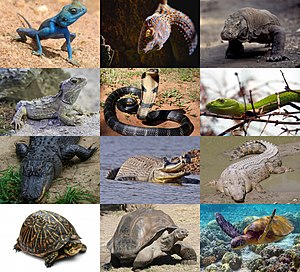 | |
| Reptilians by saurian clade listed in top-to-bottom order: six lepidosaurs and six archelosaurs. | |
| Scientific classification | |
| Domain: | Eukaryota |
| Kingdom: | Animalia |
| Phylum: | Chordata |
| Clade: | Sauropsida |
| Class: | Reptilia Laurenti, 1768 |
| Extant groups | |
See text for extinct groups. | |
Reptiles, as commonly defined, are a group of
Reptiles have been subject to several conflicting
The earliest known proto-reptiles originated around 312 million years ago during the
). Modern non-bird reptiles inhabit all the continents except Antarctica.Reptiles are tetrapod
Classification
Research history

In the 13th century, the category of reptile was recognized in Europe as consisting of a miscellany of egg-laying creatures, including "snakes, various fantastic monsters, lizards, assorted amphibians, and worms", as recorded by Beauvais in his Mirror of Nature.[6] In the 18th century, the reptiles were, from the outset of classification, grouped with the

It was not until the beginning of the 19th century that it became clear that reptiles and amphibians are, in fact, quite different animals, and
The terms Sauropsida ("lizard faces") and
In 1956,
In the late 19th century, a number of definitions of Reptilia were offered. The biological traits listed by
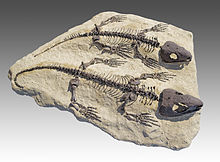
The synapsid/sauropsid division supplemented another approach, one that split the reptiles into four subclasses based on the number and position of
Those four subclasses were:- Anapsida – no fenestrae – cotylosaurs and chelonia (turtles and relatives)[a]
- mammal-like reptiles')
- Parapsidain Osborn's work.
- crocodilians, dinosaurs and pterosaurs
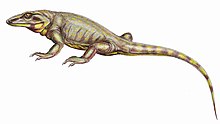
The composition of Euryapsida was uncertain.
Phylogenetics and modern definition
By the early 21st century, vertebrate paleontologists were beginning to adopt
Mammals are a
synapomorphies, as is the proper way. Instead, it is defined by a combination of the features it has and the features it lacks: reptiles are the amniotes that lack fur or feathers. At best, the cladists suggest, we could say that the traditional Reptilia are 'non-avian, non-mammalian amniotes'.[15]
Despite the early proposals for replacing the paraphyletic Reptilia with a monophyletic Sauropsida, which includes birds, that term was never adopted widely or, when it was, was not applied consistently.[2]
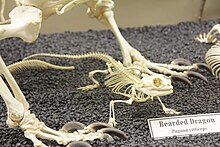
When Sauropsida was used, it often had the same content or even the same definition as Reptilia. In 1988,
A variety of other definitions were proposed by other scientists in the years following Gauthier's paper. The first such new definition, which attempted to adhere to the standards of the
Taxonomy
General classification of extinct and living reptiles, focusing on major groups.[21][22]
- Reptilia/Sauropsida
- †Parareptilia
- Eureptilia
- †Captorhinidae
- Diapsida
- †Araeoscelidia
- Neodiapsida
- †Drepanosauromorpha(placement uncertain)
- †paraphyletic)
- †Ichthyosauromorpha (placement uncertain)
- †Thalattosauria (placement uncertain)
- Sauria
- Lepidosauromorpha
- Lepidosauriformes
- Rhynchocephalia (tuatara)
- Squamata (lizards and snakes)
- †Choristodera (placement uncertain)
- †Sauropterygia (placement uncertain)
- Pantestudines (turtles and kin, placement uncertain)
- Archosauromorpha
- †Protorosauria (paraphyletic)
- †Rhynchosauria
- †Allokotosauria
- Archosauriformes
- †Phytosauria
- Archosauria
- Pseudosuchia
- Crocodilia (crocodilians)
- Ornithodira
- †Pterosauria
- Dinosauria
- †Ornithischia
- Saurischia (including birds (Aves))
- Pseudosuchia
- Lepidosauromorpha
- †
Phylogeny
The cladogram presented here illustrates the "family tree" of reptiles, and follows a simplified version of the relationships found by M.S. Lee, in 2013.[23] All genetic studies have supported the hypothesis that turtles are diapsids; some have placed turtles within Archosauromorpha,[23][24][25][26][27][28] though a few have recovered turtles as Lepidosauromorpha instead.[29] The cladogram below used a combination of genetic (molecular) and fossil (morphological) data to obtain its results.[23]
| Amniota |
| ||||||||||||||||||||||||||||||||||||||||||||||||||||||||||||||||||||||||||||||||||||||||||||||||||||||||||||||||||||||||||||||
The position of turtles
The placement of turtles has historically been highly variable. Classically, turtles were considered to be related to the primitive anapsid reptiles.
Evolutionary history
Origin of the reptiles

The origin of the reptiles lies about 310–320 million years ago, in the steaming swamps of the late Carboniferous period, when the first reptiles evolved from advanced reptiliomorphs.[20][failed verification]
The oldest known animal that may have been an
However,
Rise of the reptiles
The earliest amniotes, including stem-reptiles (those amniotes closer to modern reptiles than to mammals), were largely overshadowed by larger stem-tetrapods, such as
A 2021 examination of reptile diversity in the Carboniferous and Permian suggests a much higher degree of diversity than previously thought, comparable or even exceeding that of synapsids. Thus, the "First Age of Reptiles" was proposed.[41]
Anapsids, synapsids, diapsids, and sauropsids
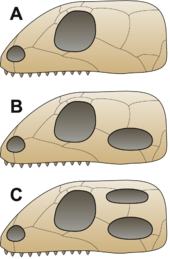
B = Synapsid,
C = Diapsid
It was traditionally assumed that the first reptiles retained an
Turtles have been traditionally believed to be surviving parareptiles, on the basis of their anapsid skull structure, which was assumed to be primitive trait.[49] The rationale for this classification has been disputed, with some arguing that turtles are diapsids that evolved anapsid skulls, improving their armor.[20] Later morphological phylogenetic studies with this in mind placed turtles firmly within Diapsida.[50] All molecular studies have strongly upheld the placement of turtles within diapsids, most commonly as a sister group to extant archosaurs.[25][26][27][28]
Permian reptiles
With the close of the
The parareptiles, whose massive
Early in the period, the modern reptiles, or crown-group reptiles, evolved and split into two main lineages: the Archosauromorpha (forebears of turtles, crocodiles, and dinosaurs) and the Lepidosauromorpha (predecessors of modern lizards and tuataras). Both groups remained lizard-like and relatively small and inconspicuous during the Permian.
Mesozoic reptiles
The close of the Permian saw the greatest mass extinction known (see the
The
Cenozoic reptiles
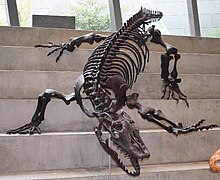
The close of the
After the extinction of most archosaur and marine reptile lines by the end of the Cretaceous, reptile diversification continued throughout the Cenozoic. Squamates took a massive hit during the K–Pg event, only recovering ten million years after it,[62] but they underwent a great radiation event once they recovered, and today squamates make up the majority of living reptiles (> 95%).[63][64] Approximately 10,000 extant species of traditional reptiles are known, with birds adding about 10,000 more, almost twice the number of mammals, represented by about 5,700 living species (excluding domesticated species).[65]
| Reptile group | Described species | Percent of reptile species |
|---|---|---|
| Squamates | 9193 | 96.3% |
| - Lizards | 5634 | 59% |
| - Snakes | 3378 | 35% |
| - Amphisbaenians | 181 | 2% |
| Turtles | 327 | 3.4% |
| Crocodilians | 25 | 0.3% |
| Rhynchocephalians | 1 | 0.01% |
| Total | 9546 | 100% |
Morphology and physiology
Circulation
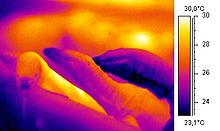
All
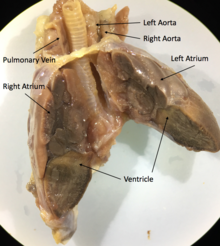
For example, Iguana hearts, like the majority of the squamates hearts, are composed of three chambers with two aorta and one ventricle, cardiac involuntary muscles.[68] The main structures of the heart are the sinus venosus, the pacemaker, the left atrium, the right atrium, the atrioventricular valve, the cavum venosum, cavum arteriosum, the cavum pulmonale, the muscular ridge, the ventricular ridge, pulmonary veins, and paired aortic arches.[69]
Some squamate species (e.g., pythons and monitor lizards) have three-chambered hearts that become functionally four-chambered hearts during contraction. This is made possible by a muscular ridge that subdivides the ventricle during
Crocodilians have an anatomically four-chambered heart, similar to birds, but also have two systemic aortas and are therefore capable of bypassing their pulmonary circulation.[71]
Metabolism
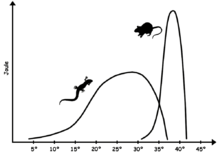
Modern non-avian reptiles exhibit some form of cold-bloodedness (i.e. some mix of poikilothermy, ectothermy, and bradymetabolism) so that they have limited physiological means of keeping the body temperature constant and often rely on external sources of heat. Due to a less stable core temperature than birds and mammals, reptilian biochemistry requires enzymes capable of maintaining efficiency over a greater range of temperatures than in the case for warm-blooded animals. The optimum body temperature range varies with species, but is typically below that of warm-blooded animals; for many lizards, it falls in the 24°–35 °C (75°–95 °F) range,[72] while extreme heat-adapted species, like the American desert iguana Dipsosaurus dorsalis, can have optimal physiological temperatures in the mammalian range, between 35° and 40 °C (95° and 104 °F).[73] While the optimum temperature is often encountered when the animal is active, the low basal metabolism makes body temperature drop rapidly when the animal is inactive.
As in all animals, reptilian muscle action produces heat. In large reptiles, like
The benefit of a low resting metabolism is that it requires far less fuel to sustain bodily functions. By using temperature variations in their surroundings, or by remaining cold when they do not need to move, reptiles can save considerable amounts of energy compared to endothermic animals of the same size.[77] A crocodile needs from a tenth to a fifth of the food necessary for a lion of the same weight and can live half a year without eating.[78] Lower food requirements and adaptive metabolisms allow reptiles to dominate the animal life in regions where net calorie availability is too low to sustain large-bodied mammals and birds.
It is generally assumed that reptiles are unable to produce the sustained high energy output necessary for long distance chases or flying.[79] Higher energetic capacity might have been responsible for the evolution of warm-bloodedness in birds and mammals.[80] However, investigation of correlations between active capacity and thermophysiology show a weak relationship.[81] Most extant reptiles are carnivores with a sit-and-wait feeding strategy; whether reptiles are cold blooded due to their ecology is not clear. Energetic studies on some reptiles have shown active capacities equal to or greater than similar sized warm-blooded animals.[82]
Respiratory system
All reptiles breathe using lungs. Aquatic turtles have developed more permeable skin, and some species have modified their cloaca to increase the area for gas exchange.[83] Even with these adaptations, breathing is never fully accomplished without lungs. Lung ventilation is accomplished differently in each main reptile group. In squamates, the lungs are ventilated almost exclusively by the axial musculature. This is also the same musculature that is used during locomotion. Because of this constraint, most squamates are forced to hold their breath during intense runs. Some, however, have found a way around it. Varanids, and a few other lizard species, employ buccal pumping as a complement to their normal "axial breathing". This allows the animals to completely fill their lungs during intense locomotion, and thus remain aerobically active for a long time. Tegu lizards are known to possess a proto-diaphragm, which separates the pulmonary cavity from the visceral cavity. While not actually capable of movement, it does allow for greater lung inflation, by taking the weight of the viscera off the lungs.[84]
Crocodilians actually have a muscular diaphragm that is analogous to the mammalian diaphragm. The difference is that the muscles for the crocodilian diaphragm pull the pubis (part of the pelvis, which is movable in crocodilians) back, which brings the liver down, thus freeing space for the lungs to expand. This type of diaphragmatic setup has been referred to as the "hepatic piston". The airways form a number of double tubular chambers within each lung. On inhalation and exhalation air moves through the airways in the same direction, thus creating a unidirectional airflow through the lungs. A similar system is found in birds,[85] monitor lizards[86] and iguanas.[87]
Most reptiles lack a secondary palate, meaning that they must hold their breath while swallowing. Crocodilians have evolved a bony secondary palate that allows them to continue breathing while remaining submerged (and protect their brains against damage by struggling prey). Skinks (family Scincidae) also have evolved a bony secondary palate, to varying degrees. Snakes took a different approach and extended their trachea instead. Their tracheal extension sticks out like a fleshy straw, and allows these animals to swallow large prey without suffering from asphyxiation.[88]
Turtles and tortoises
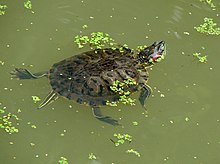
How turtles and tortoises breathe has been the subject of much study. To date, only a few species have been studied thoroughly enough to get an idea of how those turtles breathe. The varied results indicate that turtles and tortoises have found a variety of solutions to this problem.
The difficulty is that most turtle shells are rigid and do not allow for the type of expansion and contraction that other amniotes use to ventilate their lungs. Some turtles, such as the Indian flapshell (Lissemys punctata), have a sheet of muscle that envelops the lungs. When it contracts, the turtle can exhale. When at rest, the turtle can retract the limbs into the body cavity and force air out of the lungs. When the turtle protracts its limbs, the pressure inside the lungs is reduced, and the turtle can suck air in. Turtle lungs are attached to the inside of the top of the shell (carapace), with the bottom of the lungs attached (via connective tissue) to the rest of the viscera. By using a series of special muscles (roughly equivalent to a diaphragm), turtles are capable of pushing their viscera up and down, resulting in effective respiration, since many of these muscles have attachment points in conjunction with their forelimbs (indeed, many of the muscles expand into the limb pockets during contraction).[89]
Breathing during locomotion has been studied in three species, and they show different patterns. Adult female green sea turtles do not breathe as they crutch along their nesting beaches. They hold their breath during terrestrial locomotion and breathe in bouts as they rest. North American box turtles breathe continuously during locomotion, and the ventilation cycle is not coordinated with the limb movements.[90] This is because they use their abdominal muscles to breathe during locomotion. The last species to have been studied is the red-eared slider, which also breathes during locomotion, but takes smaller breaths during locomotion than during small pauses between locomotor bouts, indicating that there may be mechanical interference between the limb movements and the breathing apparatus. Box turtles have also been observed to breathe while completely sealed up inside their shells.[90]
Sound production
Compared with frogs, birds, and mammals, reptiles are less vocal. Sound production is usually limited to
Hearing in snakes
Hearing in humans relies on 3 parts of the ear; the outer ear that directs sound waves into the ear canal, the middle ear that transmits incoming sound waves to the inner ear, and the inner ear that helps in hearing and keeping your balance. Unlike humans and other mammals, snakes do not possess an outer ear, a middle ear, and a tympanum but have an inner ear structure with cochleas directly connected to their jawbone.[93] They are able to feel the vibrations generated from the sound waves in their jaw as they move on the ground. This is done by the use of mechanoreceptors, sensory nerves that run along the body of snakes directing the vibrations along the spinal nerves to the brain. Snakes have a sensitive auditory perception and can tell which direction sound being made is coming from so that they can sense the presence of prey or predator but it is still unclear how sensitive snakes are to sound waves traveling through the air.[94]
Skin
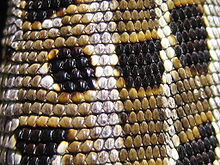
Reptilian skin is covered in a horny epidermis, making it watertight and enabling reptiles to live on dry land, in contrast to amphibians. Compared to mammalian skin, that of reptiles is rather thin and lacks the thick dermal layer that produces leather in mammals.[95] Exposed parts of reptiles are protected by
Lacking a thick dermis, reptilian leather is not as strong as mammalian leather. It is used in leather-wares for decorative purposes for shoes, belts and handbags, particularly crocodile skin.
Shedding
Reptiles shed their skin through a process called ecdysis which occurs continuously throughout their lifetime. In particular, younger reptiles tend to shed once every 5–6 weeks while adults shed 3–4 times a year.[96] Younger reptiles shed more because of their rapid growth rate. Once full size, the frequency of shedding drastically decreases. The process of ecdysis involves forming a new layer of skin under the old one. Proteolytic enzymes and lymphatic fluid is secreted between the old and new layers of skin. Consequently, this lifts the old skin from the new one allowing shedding to occur.[97] Snakes will shed from the head to the tail while lizards shed in a "patchy pattern".[97] Dysecdysis, a common skin disease in snakes and lizards, will occur when ecdysis, or shedding, fails.[98] There are numerous reasons why shedding fails and can be related to inadequate humidity and temperature, nutritional deficiencies, dehydration and traumatic injuries.[97] Nutritional deficiencies decrease proteolytic enzymes while dehydration reduces lymphatic fluids to separate the skin layers. Traumatic injuries on the other hand, form scars that will not allow new scales to form and disrupt the process of ecdysis.[98]
Excretion
In all reptiles, the urinogenital ducts and the anus both empty into an organ called a cloaca. In some reptiles, a midventral wall in the cloaca may open into a urinary bladder, but not all. It is present in all turtles and tortoises as well as most lizards, but is lacking in the monitor lizard, the legless lizards. It is absent in the snakes, alligators, and crocodiles.[99]
Many turtles, tortoises, and lizards have proportionally very large bladders.
Turtles have two or more accessory urinary bladders, located lateral to the neck of the urinary bladder and dorsal to the pubis, occupying a significant portion of their body cavity.[103] Their bladder is also usually bilobed with a left and right section. The right section is located under the liver, which prevents large stones from remaining in that side while the left section is more likely to have calculi.[104]
Digestion
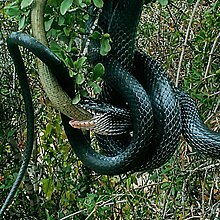
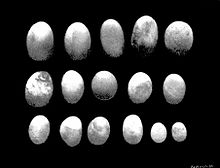
Most reptiles are insectivorous or carnivorous and have simple and comparatively short digestive tracts due to meat being fairly simple to break down and digest.
While modern reptiles are predominantly carnivorous, during the early history of reptiles several groups produced some herbivorous
Herbivorous reptiles face the same problems of mastication as herbivorous mammals but, lacking the complex teeth of mammals, many species swallow rocks and pebbles (so called
Nerves
The reptilian nervous system contains the same basic part of the amphibian brain, but the reptile cerebrum and cerebellum are slightly larger. Most typical sense organs are well developed with certain exceptions, most notably the snake's lack of external ears (middle and inner ears are present). There are twelve pairs of cranial nerves.[111] Due to their short cochlea, reptiles use electrical tuning to expand their range of audible frequencies.
Vision
Most reptiles are diurnal animals. The vision is typically adapted to daylight conditions, with color vision and more advanced visual depth perception than in amphibians and most mammals.
Reptiles usually have excellent vision, allowing them to detect shapes and motions at long distances. They often have poor vision in low-light conditions. Birds, crocodiles and turtles have three types of
Many
Some snakes have extra sets of visual organs (in the loosest sense of the word) in the form of
Most reptiles, as well as birds, possess a nictitating membrane, a translucent third eyelid which is drawn over the eye from the inner corner. In crocodilians , it protects its eyeball surface while allowing a degree of vision underwater.[115] However, many squamates, geckos and snakes in particular, lack eyelids, which are replaced by a transparent scale. This is called the brille, spectacle, or eyecap. The brille is usually not visible, except for when the snake molts, and it protects the eyes from dust and dirt.[116]
Reproduction

(1) eggshell, (2) yolk sac, (3) yolk (nutrients), (4) vessels, (5) amnion, (6) chorion, (7) air space, (8) allantois, (9) albumin (egg white), (10) amniotic sac, (11) crocodile embryo, (12) amniotic fluid
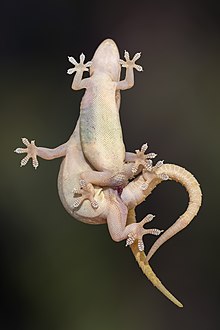

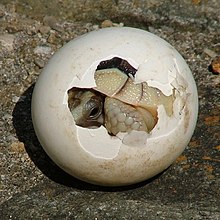
Reptiles generally
Most reptiles lay amniotic eggs covered with leathery or calcareous shells. An
Asexual reproduction has been identified in squamates in six families of lizards and one snake. In some species of squamates, a population of females is able to produce a unisexual diploid clone of the mother. This form of asexual reproduction, called parthenogenesis, occurs in several species of gecko, and is particularly widespread in the teiids (especially Aspidocelis) and lacertids (Lacerta). In captivity, Komodo dragons (Varanidae) have reproduced by parthenogenesis.
Parthenogenetic species are suspected to occur among chameleons, agamids, xantusiids, and typhlopids.
Some reptiles exhibit temperature-dependent sex determination (TDSD), in which the incubation temperature determines whether a particular egg hatches as male or female. TDSD is most common in turtles and crocodiles, but also occurs in lizards and tuatara.[120] To date, there has been no confirmation of whether TDSD occurs in snakes.[121]
Cognition
Reptiles are generally considered less intelligent than mammals and birds.
There is evidence that reptiles are
Defense mechanisms
Many small reptiles, such as snakes and lizards, that live on the ground or in the water are vulnerable to being preyed on by all kinds of carnivorous animals. Thus, avoidance is the most common form of defense in reptiles.[131] At the first sign of danger, most snakes and lizards crawl away into the undergrowth, and turtles and crocodiles will plunge into water and sink out of sight.
Camouflage and warning
Reptiles tend to avoid confrontation through camouflage. Two major groups of reptile predators are birds and other reptiles, both of which have well developed color vision. Thus the skins of many reptiles have cryptic coloration of plain or mottled gray, green, and brown to allow them to blend into the background of their natural environment.[132] Aided by the reptiles' capacity for remaining motionless for long periods, the camouflage of many snakes is so effective that people or domestic animals are most typically bitten because they accidentally step on them.[133]
When camouflage fails to protect them,
In contrast to the normal drab coloration of most reptiles, the lizards of the genus Heloderma (the
Alternative defense in snakes
Camouflage does not always fool a predator. When caught out, snake species adopt different defensive tactics and use a complicated set of behaviors when attacked. Some species, like cobras or hognose snakes, first elevate their head and spread out the skin of their neck in an effort to look large and threatening. Failure of this strategy may lead to other measures practiced particularly by cobras, vipers, and closely related species, which use
Defense in crocodilians
When a

Some species try to bite immediately. Some will use their heads as sledgehammers and literally smash an opponent, some will rush or swim toward the threat from a distance, even chasing the opponent onto land or galloping after it.[142] The main weapon in all crocodiles is the bite, which can generate very high bite force. Many species also possess canine-like teeth. These are used primarily for seizing prey, but are also used in fighting and display.[143]
Shedding and regenerating tails
Reptiles that are capable of shedding their tails can partially regenerate them over a period of weeks. The new section will however contain cartilage rather than bone, and will never grow to the same length as the original tail. It is often also distinctly discolored compared to the rest of the body and may lack some of the external sculpting features seen in the original tail.[146]
Relations with humans
In cultures and religions

Dinosaurs have been widely depicted in culture since the English palaeontologist Richard Owen coined the name dinosaur in 1842. As soon as 1854, the Crystal Palace Dinosaurs were on display to the public in south London.[147][148] One dinosaur appeared in literature even earlier, as Charles Dickens placed a Megalosaurus in the first chapter of his novel Bleak House in 1852.[c] The dinosaurs featured in books, films, television programs, artwork, and other media have been used for both education and entertainment. The depictions range from the realistic, as in the television documentaries of the 1990s and first decade of the 21st century, to the fantastic, as in the monster movies of the 1950s and 1960s.[148][150][151]
The snake or serpent has played a powerful
The turtle has a prominent position as a symbol of steadfastness and tranquility in religion, mythology, and folklore from around the world.
Medicine

Deaths from
Lizards such as the Gila monster produce toxins with medical applications. Gila toxin reduces plasma glucose; the substance is now synthesised for use in the anti-
Geckos have also been used as medicine, especially in China.[164] Turtles have been used in Chinese traditional medicine for thousands of years, with every part of the turtle believed to have medical benefits. There is a lack of scientific evidence that would correlate claimed medical benefits to turtle consumption. Growing demand for turtle meat has placed pressure on vulnerable wild populations of turtles.[165]
Commercial farming
Crocodiles are protected in many parts of the world, and are
Snakes are also farmed, primarily in East and Southeast Asia, and their production has become more intensive in the last decade. Snake farming has been troubling for conservation in the past as it can lead to overexploitation of wild snakes and their natural prey to supply the farms. However, farming snakes can limit the hunting of wild snakes, while reducing the slaughter of higher-order vertebrates like cows. The energy efficiency of snakes is higher than expected for carnivores, due to their ectothermy and low metabolism. Waste protein from the poultry and pig industries is used as feed in snake farms.[168] Snake farms produce meat, snake skin, and antivenom.
Turtle farming is another known but controversial practice. Turtles have been farmed for a variety of reasons, ranging from food to traditional medicine, the pet trade, and scientific conservation. Demand for turtle meat and medicinal products is one of the main threats to turtle conservation in Asia. Though commercial breeding would seem to insulate wild populations, it can stoke the demand for them and increase wild captures.[169][165] Even the potentially appealing concept of raising turtles at a farm to release into the wild is questioned by some veterinarians who have had some experience with farm operations. They caution that this may introduce into the wild populations infectious diseases that occur on the farm, but have not (yet) been occurring in the wild.[170][171]
Reptiles in captivity
A herpetarium is a zoological exhibition space for reptiles and amphibians.
In the Western world, some snakes (especially relatively docile species such as the
Turtles and tortoises are increasingly popular pets, but keeping them can be challenging due to their particular requirements, such as temperature control, the need for UV light sources, and a varied diet. The long lifespans of turtles and especially tortoises mean they can potentially outlive their owners. Good hygiene and significant maintenance is necessary when keeping reptiles, due to the risks of Salmonella and other pathogens.[175] Regular hand-washing after handling is an important measure to prevent infection.
See also
Further reading
- ISBN 978-0-471-16466-1.
- Landberg, Tobias; Mailhot, Jeffrey; Brainerd, Elizabeth (2003). "Lung ventilation during treadmill locomotion in a terrestrial turtle, Terrapene carolina". PMID 12939371.
- Pianka, Eric; Vitt, Laurie (2003). Lizards: Windows to the evolution of diversity. University of California Press. pp. 116–118. ISBN 978-0-520-23401-7.
- Pough, Harvey; Janis, Christine; Heiser, John (2005). Vertebrate Life. Pearson Prentice Hall. ISBN 978-0-13-145310-4.
Notes
- ^
This taxonomy does not reflect modern molecular evidence, which places turtles within Diapsida.
- ^ "The copperhead is a pit viper and, like others pit vipers, it has heat-sensitive pit organs on each side of its head between the eye and the nostril. These pits detect objects that are warmer than the environment and enable copperheads to locate nocturnal, mammalian prey."[114]
- ^ "Michaelmas term lately over, and the Lord Chancellor sitting in Lincoln's Inn Hall. Implacable November weather. As much mud in the streets, as if the waters had but newly retired from the face of the earth, and it would not be wonderful to meet a Megalosaurus, forty feet long or so, waddling like an elephantine lizard up Holborne Hill."[149]
References
- ^ "Reptile Database News". reptile-database.org. Retrieved 2022-05-25.
- ^ PMID 15545258.
- ^ )
- PMID 24586565.
- ^ S2CID 7041966.
- ISBN 9780226260709.
- ^ Linnaeus, Carolus (1758). Systema naturae per regna tria naturae: Secundum classes, ordines, genera, species, cum characteribus, differentiis, synonymis, locis [System of Nature through the Three Natural Kingdoms, According to classes, orders, genera, species, with characters, differences, synonyms, places] (in Latin) (10th ed.). Holmiae (Laurentii Salvii). Retrieved September 22, 2008.
- ^ "Amphibia". Encyclopædia Britannica (9th ed.). 1878.
- ^ Laurenti, J.N. (1768). Specimen medicum, exhibens synopsin reptilium emendatam cum experimentis circa venena [Medical Specimen: Presenting an improved synopsis of reptiles with experiments on poisons] (in Latin). Archived from the original (facsimile) on 2015-09-04. — shows the mixed composition of Reptilia.
- ^ Latreielle, P.A. (1804). Nouveau Dictionnaire à Histoire Naturelle [New Dictionary of Natural History] (in French). p. xxiv. cited in Latreille, P.A. (1825). Familles naturelles du règne animal, exposés succinctement et dans un ordre analytique [Natural families of the animal kingdom, succinctly presented in analytical order] (in French).
- ^ Huxley, T.H. (1863). "The structure and classification of the Mammalia". Medical Times and Gazette. Hunterian lectures.
- .
- .
- ^ Lydekker, Richard (1896). Reptiles and Fishes. The Royal Natural History. London, UK: Frederick Warne & Son. pp. 2–3. Retrieved March 25, 2016.
- ^ ISBN 0-19-860426-2.
- ^ Osborn, H.F. (1903). "The reptilian subclasses Diapsida and Synapsida and [the] early history of Diaptosauria". Memoirs of the American Museum of Natural History. 1: 451–507.
- ^ Romer, A.S. (1966) [1933]. Vertebrate Paleontology (3rd ed.). Chicago, IL: University of Chicago Press.
- .
- PMID 18761282.
- ^ a b c Laurin, M.; Reisz, R.R. (1995). "A reevaluation of early amniote phylogeny" (PDF). .
- ISBN 978-0-632-05637-8. Archived from the originalon 2008-10-19. Retrieved 2015-02-15.
- ISBN 978-0-632-05637-8.
- ^ PMID 24256520.
- PMID 10508547.
- ^ PMID 9826682.
- ^ PMID 15625185.
- ^ PMID 17719245.
- ^ S2CID 12116018.
- PMID 21775315.
- ^ a b c d Romer, A.S; Parsons, T.S. (1985) [1977]. The Vertebrate Body (5th ed.). Philadelphia, PA: Saunders.
- PMID 23725759.
- PMID 22839781.
- PMID 19389226. article 82.
- S2CID 204992355.
- JSTOR 4011517. Archived from the originalon June 4, 2011.
- hdl:1959.9/57256.
- S2CID 140568921.
- ^ "Earliest Evidence For Reptiles". Sflorg.com. 2007-10-17. Archived from the original on July 16, 2011. Retrieved March 16, 2010.
- ISBN 978-1-84028-152-1.
- S2CID 31298396. Archived from the original(PDF) on 2008-05-22. Retrieved 2010-08-19.
- ^ .
- ^ doi:10.1130/G31182.1.
- ^ PMID 20106856.
- ^ Blackwell Science. p. 154– via Google Books.
- PMID 15306328.
- .
- ^ .
- S2CID 25065918.
- ISBN 978-0-632-05614-9
- S2CID 4264378.
- ^ ISBN 978-0-471-38461-8.
- ^ PMID 18198148.
- PMID 24449041.
- .
- ^ Modesto, Sean; Reisz, Robert; Scott, Diane (2011). A neodiapsid reptile from the Lower Permian of Oklahoma. 71st Annual Meeting. Program and Abstracts. Society of Vertebrate Paleontology. p. 160.
- University of Maryland, Department of Geology.
- S2CID 4416186.
- ISBN 978-0-253-34374-1.
- S2CID 84097919.
- .
- .
- PMID 23236177.
- ^ "The Reptile Database". Retrieved February 23, 2016.
- PMID 25803280.
- ^ "Numbers of threatened species by major groups of organisms (1996–2012)" (PDF). IUCN Red List (Report). IUCN. 2010. Archived from the original (PDF) on February 4, 2013. Retrieved January 30, 2013.
- PMID 23544091.
- S2CID 20040550.
- ^ DABVP, Ryan S. De Voe DVM MSpVM DACZM. "Reptilian cardiovascular anatomy and physiology: evaluation and monitoring (Proceedings)". dvm360.com. Archived from the original on 2018-11-06. Retrieved 2017-04-22.
- ^ "Iguana Internal Body Parts". Reptile & Parrots Forum. Archived from the original on 2017-04-22. Retrieved 2017-04-22.
- PMID 14581594.
- .
- ^ Huey, R.B. & Bennett, A.F. (1987):Phylogenetic studies of coadaptation: Preferred temperatures versus optimal performance temperatures of lizards. Evolution No. 4, vol 5: pp. 1098–1115 PDF
- ^ Huey, R.B. (1982): Temperature, physiology, and the ecology of reptiles. Side 25–91. In Gans, C. & Pough, F.H. (red), Biology of the Reptili No. 12, Physiology (C). Academic Press, London.artikkel
- ^ Spotila J.R. & Standora, E.A. (1985) Environmental constraints on the thermal energetics of sea turtles. Copeia 3: 694–702
- ISBN 978-0-253-21313-6.
- ^ Spotila, J.R.; O'Connor, M.P.; Dodson, P.; Paladino, F.V. (1991). "Hot and cold running dinosaurs: body size, metabolism and migration". Modern Geology. 16: 203–227.
- ISBN 978-0-8053-7473-5
- ^ .
- ISBN 978-0-632-03517-5.
- PMID 493968.
- S2CID 17932602.
- PMID 10563436.
- ISBN 978-1-55209-605-5.
- S2CID 9901649.
- S2CID 206522844.
- S2CID 4456381.
- PMID 25404314.

- ^ Chiodini, Rodrick J.; Sundberg, John P.; Czikowsky, Joyce A. (January 1982). Timmins, Patricia (ed.). "Gross anatomy of snakes". Veterinary Medicine/Small Animal Clinician – via ResearchGate.
- PMID 25376734.

- ^ PMID 12939371.
- S2CID 225069598.
- ISBN 978-0128151600.
- S2CID 11909208.
- JSTOR 44149431.
- ISBN 978-0-471-29505-1
- ISBN 9780470752432.
- ^ PMID 22417690.
- ^ ISBN 9781118782941.
- ^ Rand, Herbert W. (1950). The Chordates. Balkiston.
- ISBN 978-3-662-05014-9.
- ^ Paré, Jean (11 January 2006). Reptile basics: Clinical anatomy 101 (PDF). North American Veterinary Conference. Vol. 20. pp. 1657–1660.
- PMID 17401130.
- ^ Wyneken, Jeanette; Witherington, Dawn (February 2015). "Urogenital System" (PDF). Anatomy of Sea Turtles. 1: 153–165.
- ISBN 9781416064770.
- ISBN 978-0-387-96515-4. Retrieved November 1, 2012.
- ^ ISBN 978-0-412-46110-1.
- .
- PMID 17254987.

- doi:10.1139/z03-122.
- S2CID 28832109.

- ^ "de beste bron van informatie over cultural institution. Deze website is te koop!". Curator.org. Archived from the original on September 17, 2009. Retrieved March 16, 2010.
- ^ a b Brames, Henry (2007). "Aspects of Light and Reptile Immunity". Iguana: Conservation, Natural History, and Husbandry of Reptiles. 14 (1). International Reptile Conservation Foundation: 19–23.
- ^ The evolutionary ecology of bird and reptile photoreceptor spectral sensitivities
- ^ "Northern copperhead". Smithsonian's National Zoo & Conservation Biology Institute. 25 April 2016. Retrieved 12 February 2020.
- ^ "Nictitating membrane". Encyclopædia Britannica. Anatomy. Retrieved 2020-02-20.
- ^ "Catalina Island Conservancy". www.catalinaconservancy.org. Retrieved 2020-02-20.
- ^ "Male reproductive behaviour of Naja oxiana (Eichwald, 1831) in captivity, with a case of unilateral hemipenile prolapse". Herpetology Notes. 2018.
- ISBN 978-0-931625-43-5.
- S2CID 59475679.
- ISBN 978-1-55407-366-5.
- ISBN 978-0-470-84346-8. Retrieved March 16, 2010 – via Google Books.
- ^ Jerison, Harry J. "Figure of relative brain size in vertebrates". Brainmuseum.org. Retrieved March 16, 2010.
- ISBN 978-0-86840-456-1.
- ^ "Latency in Problem Solving as Evidence for Learning in Varanid and Helodermatid Lizards, with Comments on Foraging Techniques". ResearchGate. Retrieved 2020-02-20.
- ISBN 978-1-55297-613-5.
- ^ "Even turtles need recess: Many animals – not just dogs, cats, and monkeys – need a little play time". ScienceDaily (Press release). Oct 2010. Retrieved 2020-02-20.
- ^ Angier, Natalie (16 December 2006). "Ask Science". The New York Times. Retrieved September 15, 2013.
- S2CID 207962281.
- ^ "Sea turtles use flippers to manipulate food". ScienceDaily (Press release). March 2018. Retrieved 2020-02-20.
- PMID 31627409.
- ^ "Reptile". Britannica.com. Behaviour. animal. Retrieved March 16, 2010.
- ^ "Reptile and amphibian defense systems". Animal behavior (resource). Teachervision.fen.com. Retrieved March 16, 2010.
- hdl:2263/25851. Retrieved 9 Feb 2023.
- ISBN 978-0-7301-0088-1.
- ISBN 978-0-76147-938-3. Retrieved August 18, 2014.
The bold patterns of the venomous gila monster are an example of warning coloration.
- S2CID 7159917.)
{{cite journal}}: CS1 maint: multiple names: authors list (link - S2CID 14576682.)
{{cite journal}}: CS1 maint: multiple names: authors list (link - ISBN 978-1-4027-3181-5.
- PMID 23219381.
- S2CID 85722243.
- ISBN 978-0-520-24406-1.
- ^ "Ferocious Crocs". Animal Planet. Animal.discovery.com. 2008-09-10. Retrieved March 16, 2010.
- PMID 22431965.

- ^ Marshall, Michael. "Gecko's amputated tail has life of its own". Zoologger. New Scientist. Life. Retrieved August 18, 2014.
- ISBN 978-0-520-23401-7.
- PMID 20334040.
- ^ Torrens, Hugh. "Politics and paleontology". The Complete Dinosaur. pp. 175–190.
- ^ ISBN 978-0-253-33349-0.
- ISBN 978-1-85326-082-7.
- ISBN 978-0-312-26226-6.
- ISBN 978-0-8109-0922-9.
- ISBN 978-0-7537-0381-6. Archived from the originalon 2009-02-09.
- ISBN 978-1-56459-898-1.
- ISBN 978-0-500-27928-1.
- ^ Genesis 3:1
- ISBN 978-0-8018-8611-9.
- ISBN 0-486-43338-2.
- ISBN 978-0-313-31505-3.
- ^ Sinha, Kounteya (25 July 2006). "No more the land of snake charmers..." The Times of India.
- PMID 8939322.
- PMID 23593597.
- ^ Casey, Constance (26 April 2013). "Don't call it a monster". Slate.
- ^ "Alzheimer's research seeks out lizards". BBC News. 5 April 2002.
- ^ Wagner, P.; Dittmann, A. (2014). "Medicinal use of Gekko gecko (Squamata: Gekkonidae) has an impact on agamid lizards". Salamandra. 50 (3): 185–186.

- ^ a b "The threat of traditional medicine: China's boom may mean doom for turtles". Mongabay Environmental News. 2014-08-08. Retrieved 2020-01-16.
- ^ Lyman, Rick (30 November 1998). "Alligator farmer feeds demand for all the parts". Anahuac Journal. The New York Times. Retrieved November 13, 2013.
- ISBN 978-1-59228-178-7.
- ISSN 0030-6053.
- ISSN 1365-3008.
- ^ Jacobson, Elliott R. (January 1996). "Marine turtle farming and health issues". Marine Turtle Newsletter (guest editorial). Vol. 72. pp. 13–15.
- ^ "This turtle tourist center also raises endangered turtles for meat". National Geographic News. 2017-05-25. Archived from the original on January 16, 2020. Retrieved 2020-01-16.
- ISBN 978-1-56098-648-5.
- ^ a b Virata, John B. "5 Great Beginner Pet Lizards". Reptiles Magazine. Retrieved 28 May 2017.
- ^ McLeod, Lianne. "An Introduction to Green Anoles as Pets". The Spruce. Retrieved 28 May 2017.
- ^ "Turtles can make great pets, but do your homework first". phys.org. Retrieved 2020-01-15.
External links
 Data related to Reptilia at Wikispecies
Data related to Reptilia at Wikispecies Reptilia at Wikibooks
Reptilia at Wikibooks- . Encyclopædia Britannica (11th ed.). 1911.
- "Reptile phylogeny". whozoo.org. Herpetology.
- Reptile images. 1833.
{{cite book}}:|website=ignored (help) - "Sri Lanka wildlife information database". wildreach.com.
- "Biology of the reptilia". carlgans.org. — an online full text copy of a 22 volume 13,000 page summary of the state of reptile research.



